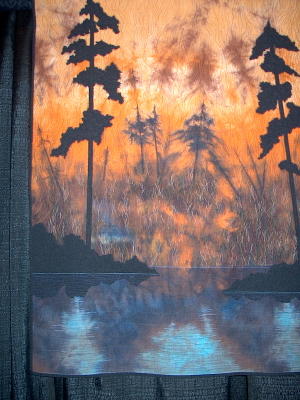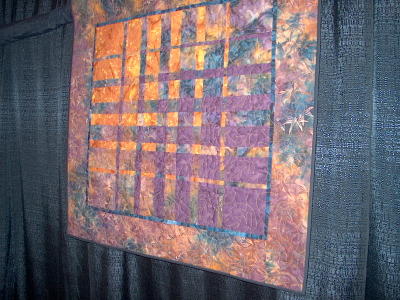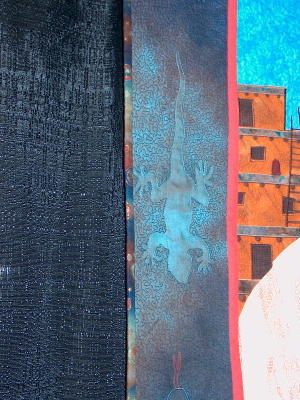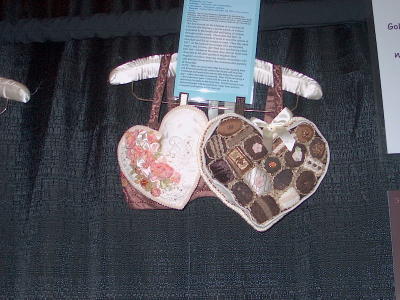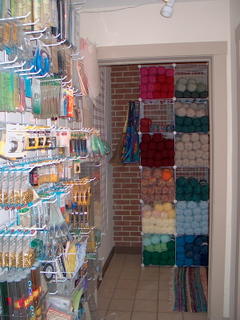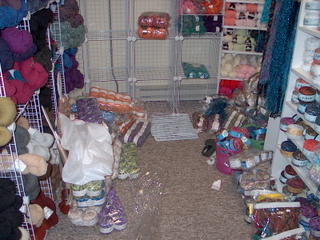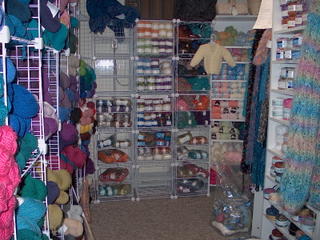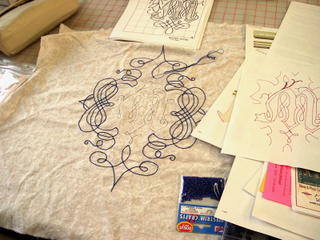Cynthia writes:
Kim was out all day today, so I was alone in the store. It was a typical day full of problem solving, but at our slower, summer pace.
The first was a customer who showed us a problem that we had already solved. These are my favorite types of problems. Shirley had come in a few days ago and showed Kim that her serger had chewed up a shirt she was making. Kim found a beautiful fabric that covered the chew mark and made the shirt look even better than the original. Shirley was so happy that she brought Kim a bag of Hershey’s dark chocolate with almonds. I knew that Kim would not want to eat the entire bag by herself, so I did her a favor and had a few pieces. Normally we do not get chocolate for solving problems. That is probably good.
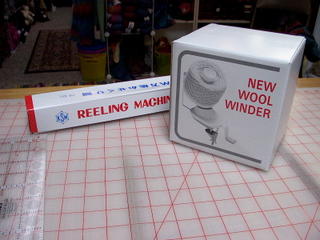 Next problem. A customer wondered how to wind skeins of yarn easily. My solution: An umbrella swift ("reeling machine") and ball ("wool") winder. I have had my own set for about 15 years, since long before owning a shop, and I cannot imagine being a knitter and not having these tools. They are much better than knees or the back of a chair--or even a helpful child. The umbrella swift unfolds like an umbrella, and looks like a Ferris wheel or merry-go-round, depending on which position you prefer. You then use the ball winder to …. well, wind the ball of yarn. Most knitters hate buying these tools because they would rather buy yarn; each part is close to $50. (Kim is always puzzled by this dread of buying the ball winder, given how much quilters spend on their tools—just beginning with sewing machines.) No, a swift and ball winder are not glamorous, but like new tires on a car or the roof of a house, they make life easier.
Next problem. A customer wondered how to wind skeins of yarn easily. My solution: An umbrella swift ("reeling machine") and ball ("wool") winder. I have had my own set for about 15 years, since long before owning a shop, and I cannot imagine being a knitter and not having these tools. They are much better than knees or the back of a chair--or even a helpful child. The umbrella swift unfolds like an umbrella, and looks like a Ferris wheel or merry-go-round, depending on which position you prefer. You then use the ball winder to …. well, wind the ball of yarn. Most knitters hate buying these tools because they would rather buy yarn; each part is close to $50. (Kim is always puzzled by this dread of buying the ball winder, given how much quilters spend on their tools—just beginning with sewing machines.) No, a swift and ball winder are not glamorous, but like new tires on a car or the roof of a house, they make life easier.
On we go with more problems. It is midday. Kim calls me in a panic. The Noro Kureyon felted purse that she knit had a dropped stitch in it, and after she started to felt it, she got a runner, just like the runner in a stocking. She is delightfully dramatic: “I might never want to knit again after this!” She was coming to the shop to pick something else up anyway, so she brought it in for me to fix.
 Deb was teaching quilting, and she suggested that we add a loop of yarn, and then pick up the stitches. Thanks, Deb. It worked. (And don't you think her student's table runner is charming?)
Deb was teaching quilting, and she suggested that we add a loop of yarn, and then pick up the stitches. Thanks, Deb. It worked. (And don't you think her student's table runner is charming?)
Kim took the purse home, and later called to report that after the complete felting, the problems were invisible. She will continue knitting. That is what I love about felting: It always felts out.
I had a lull in the afternoon, so I decided to work on a quilted wallhanging. We had run out of my preferred quilt batting, so I decided to use thin garment batting instead. When I started free-motion quilting, the stitches were much bigger than I was used to. It looked awful. I put it aside and will rip it out later, and then use the regular batting. I wrote down “batting” in our order book.
I had two customers this afternoon who wanted to make afghans and needed to know how much yarn to buy. That is always hard. It depends on needle size, afghan size desired, type of yarn used…. Most people don’t use a pattern, which would tell how much yarn to buy; they just want to make a simple garter stitch afghan. Most of the time they choose yarn that bears no resemblance to any pattern we carry. I figured it out for both people, and off they went. I always pray a little bit after people leave in these circumstances. “Please, let me have been right. Or if I was wrong and she needs more yarn, please let us have enough of that color in that dye lot.”
By 5:00, one of our knitting teachers came by, and we spent an hour figuring out what she will teach this fall and when. (Look for cables, Fair Isle, felted mittens, a great technique class on casting on, binding off, and other tricks, plus a nice sampler afghan class.)
 She left at 6:00, as my shadow-knitting class came in. This group started in April, and we have all been working out of Vivian Hoxbro’s beautiful book. One of us is making the Rainbow Jacket, one is making the Sawtooth Sweater, and three of us (including me) are making the Block Pullover. The picture you see here is the progress of the sweaters.
She left at 6:00, as my shadow-knitting class came in. This group started in April, and we have all been working out of Vivian Hoxbro’s beautiful book. One of us is making the Rainbow Jacket, one is making the Sawtooth Sweater, and three of us (including me) are making the Block Pullover. The picture you see here is the progress of the sweaters.
Mine is the middle sweater, the one with the strong rainbow. Look closely, and you will see that it was now my turn to have a problem that I needed to solve.
I hadn’t knitted on the sweater for a few weeks. Remember how your English teacher always told you to put away a paper after you wrote it, so you could revise it with a fresh eye? Sometimes when you get away from something, you notice problems that you hadn’t seen before. I looked at my sweater, and instantly I could tell something was wrong. It turned out that I made half my blocks with 5 stripes, and the other half with 6 stripes. We all talked about my problem and what I should do about it, and as we continued to talk it through, the full extent of my problem sank in with all the other knitters, and I had 3 sets of very big eyes staring at me.
I spoke for them: “I have made a pillow.”
The sweater was too far along to bother ripping halfway back. If I had kept it, the shoulders would have been askew. Okay. I admit I was traumatized. It had been a lot of knitting on size 2 needles.
But I had never been totally thrilled with my rainbow anyway. Rainbows, unfortunately, have a tinge of orange in them. I like wearing blues. So I chose new yarns, in a wash of blue-greens, blues, and purples. The great thing about fiber is that you are free make your own rainbow.
And I cast on a new sweater. After everyone left, I got out the sewing machine, and I made the pillow.
It’s better this way. Really. We now have a sample of shadow knitting right in the shop, so I don’t have to bring my sweater back and forth to show people, and in the end, I will have a sweater with colors I like better. I was having a blast making the sweater, so I don’t mind working more on shadow knitting. Most of all, I was relieved that I didn’t have to tell anyone else what I had to tell myself—that the sweater was not salvagable.
 I should not say this aloud, because I know that there are those knitters who like knitting pillows—and I think it’s fine if a knitter likes knitting pillows—some of my best friends like knitting pillows—but although I do not mind owning pillows, I truly hate knitting pillows. The truth of the matter is that I only like knitting socks and sweaters. It is my blessed fortune that I never knew I was knitting a pillow. I thought all along, blissfully, that it was a sweater. There is love knitted into this pillow, and in a pillow, the orange looks great. Everything always works out the right way in the end. Check out the shadow checks. How cool is that?
I should not say this aloud, because I know that there are those knitters who like knitting pillows—and I think it’s fine if a knitter likes knitting pillows—some of my best friends like knitting pillows—but although I do not mind owning pillows, I truly hate knitting pillows. The truth of the matter is that I only like knitting socks and sweaters. It is my blessed fortune that I never knew I was knitting a pillow. I thought all along, blissfully, that it was a sweater. There is love knitted into this pillow, and in a pillow, the orange looks great. Everything always works out the right way in the end. Check out the shadow checks. How cool is that?

